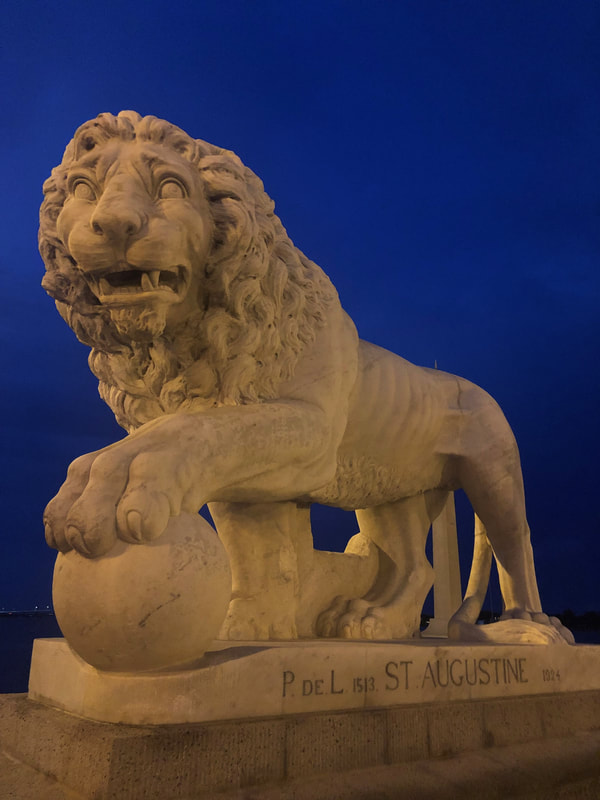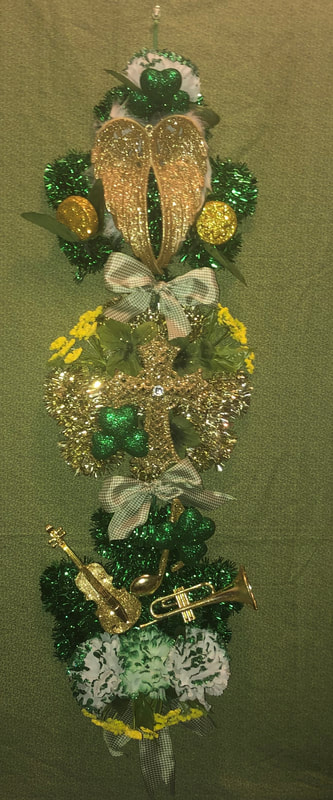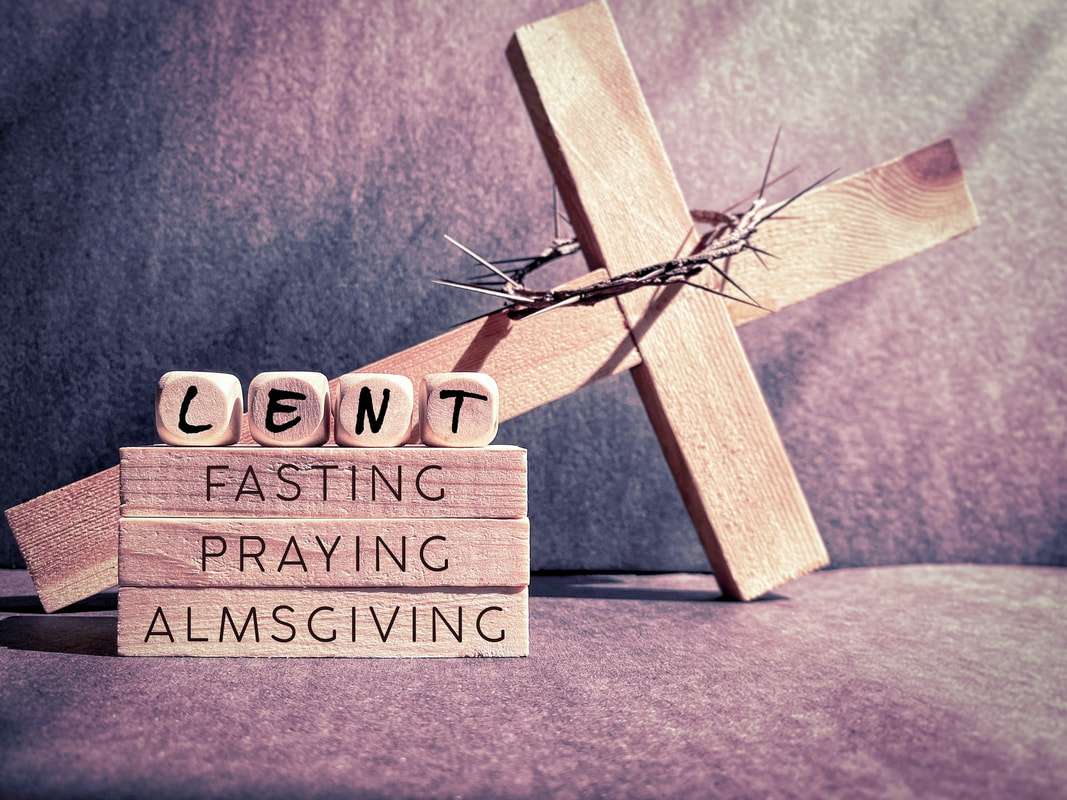|
On April 25 each year, we celebrate the Feast of St. Mark the Evangelist. St. Mark is traditionally held to be a co-worker and companion of Peter and Paul, as well as cousin to Barnabas. He accompanied Peter on his preaching travels, writing down the sermons and parables that eventually became his Gospel. He was martyred around 68, in the city of Alexandria. His gospel is the shortest of the four, even though it was composed first.
But long before Mark journeyed around, spreading the Good News, his work was foretold. In the Book of Ezekiel, that prophet records a vision of “four living creatures… Each of the four had a human face, and on the right a face of a lion, and on the left the face of an ox, and each had the face of an eagle…And the appearance of the living creatures seemed like burning coals of fire.” (Ez 1:5, 10, 14) These four creatures are usually understood as symbols of the four evangelists: the winged man, or angel, is associated with Matthew, the eagle symbolizes John, the ox is for Luke and the lion represents Mark. These same four creatures will appear again in the book of Revelation, which says, “In the center and around the throne, there were four living creatures covered with eyes in front and in back. The first creature resembled a lion, the second was like a calf, the third had a face like that of a human being and the fourth looked like an eagle in flight.” (Rev 4:6-7) On the Feast of St. Mark, let’s reflect a little on why the lion is a symbol for him. There are a few reasons. First of all, the Gospel of Mark opens differently than the other gospels. There is no philosophy or infancy narrative. It gets right to the point by proclaiming straight away, through the voice of John the Baptist, the imminent arrival of the Messiah. John the Baptist is presented as a mighty voice, like a lion roaring in the desert, “Prepare the way of the Lord! Make straight his paths!” (Mk 1:3) The time is now. A response is urgently required, just as if we were to meet a wild lion in the flesh. The second reason for the lion symbolism comes from the Old Testament, specifically the title the “lion of Judah.” In the book of Genesis, Jacob gives his blessing to his son, Judah, and calls him a young lion, crouching down, and proclaims that not only will the “scepter never depart from Judah,” (Gen 49:10) but that tribute and the people’s obedience will also come to him. This prophetic poem is a foreshadowing of the Messiah that Mark proclaims, Jesus, the true Lion of Judah who will be victorious over all his enemies and will be given tribute and obedience. The gospel of Mark itself resembles an energetic lion, in that it races from event to event, hardly slowing down. It has a vivid style, energetically detailing the events of Jesus’ life, as the kingdom of God breaks into the lives of humans. Ultimately, this gospel focuses on Jesus’ steady march to the cross. In fact, the Gospel of Mark has sometimes been called a passion narrative with a long introduction. Mark introduces Jesus as the son of God from the beginning. There is no doubt that this is the Messiah, the strong, kingly, divine Son of God who will fulfill all of the Messianic prophecies. In Mark’s Gospel we see “the paradox of the Messiah who enters into his glorious reign only through the self-abasement of the cross.” * Perhaps C.S. Lewis conveyed something about the symbolism of the lion as well, in his Narnia books. He frequently described Aslan, the Lion king, as a good lion, just not a tame one. In describing the risen Aslan, he wrote “People … sometimes think that a thing cannot be good and terrible at the same time. If the children had ever thought so, they were cured of it now. For when they tried to look at Aslan’s face, they just caught a glimpse of the golden mane and the great, royal, solemn, overwhelming eyes; and then they found they couldn’t look at him and went all trembly.”** Lions are strong, majestic, powerful, noble and fierce. There is simply something in their nature that commands respect and loyalty. The winged lion has also been a symbol for many centuries of the city of Venice, due to a claim that St. Mark stopped there once and beheld an angel in the shape of a lion. Back in the U.S. there are four well-known lions that guard the city of St. Augustine, Florida, which claims to be the first place the Mass was said in the U.S. The four lions, Fiel and Firme (Faithful and Firm) and Pax and Peli (Peace and Happiness) are on either end of the Bridge of Lions. These imposing stone statues stand in front of a sign that reminds all visitors the “Lions are under video recording.” Just in case they may suddenly come to life, jump off that stone pedestal and into our lives in a very real way - in much the same way, in fact, that the Gospel of Mark tries to show us the Son of God jumps into the sad story of humanity, invigorating it, energizing it, redeeming it. *by Mary Healy, in the April 2023 Magnificat, p. 281 ** from The Lion, The Witch and The Wardrobe
0 Comments
“Behold, behold, the wood of the cross, on which is hung our salvation. O Come, let us adore.”
These familiar words are often intoned each year at the Good Friday service. On this somber day that we yet call ‘good,” what further words can be said? Perhaps just a few. Looking at the cross of Christ we can say “Thank You.” Thank you for being born as a baby, in smallness and vulnerability. Thank you for growing into a toddler, needing to hold hands to walk. Thank you for listening to Mary and Joseph, for your presence in the home and in the workshop. Thank you for your courage, in speaking boldly as a young man. Thank you for your miracles and your healings, for giving hope and help to the desperate. Thank you for your focus, in striving to fulfill the will of the father. Thank you for not wavering in your walk to Jerusalem, despite knowing what it would bring. Thank you for enduring loneliness and abandonment. Thank you for your agony. Thank you for your death. Thank you for your life. Most of all, thank you for your invitation. Thank you for inviting us to see your face in our children. Thank you for inviting us to be patient as our toddlers grow and grasp, reach and grab. Thank you for being present in our homes and in our work. Thank you for giving your mother to us, and our big family of saints in heaven. Thank you for the hope and healing you grant us, seen and unseen. Thank you for your guidance and perseverance with us, and with our families. Thank you for not leaving us. Thank you for not forgetting us. Thank you for loving us. Is there anything else we can say, as we gaze at the cross of Christ? Perhaps these two words are appropriate - “I’m sorry.” I’m sorry when I forgot you. I’m sorry when I refused your invitation. I’m sorry when I put myself ahead of my family. I’m sorry when I didn’t want you in my home or in my work. I’m sorry when I didn’t speak of you, at the dinner table or the coffee shop. I’m sorry when I didn’t speak to you, at bedtime or in the car. I’m sorry when I thought I knew better than you. I’m sorry when I didn’t see you in others. I’m sorry for not listening to you. I’m sorry for not believing in you. There are two other words that we can pray today, on this good day when the Son of God gave his life for us. We can say “I forgive.” I forgive my spouse. I forgive my sons. I forgive my daughters. I forgive my mother and mother-in-law. I forgive my father and father-in-law. I forgive my sisters. I forgive my brothers. I forgive my boss. I forgive my coworkers. I forgive my neighbors. I forgive our leaders. I forgive myself. Thank you. I’m sorry. I forgive. Six small words we can pray as we walk with the Church through Good Friday and into Holy Saturday, as we wait in joyful hope for the dawning of Easter joy. In the Gospel of Matthew, Jesus gives a lengthy discourse on how his disciples should act. In Chapter 6, he spends time explaining how disciples should give alms, how they should pray and how they should fast. These are the same three actions we focus on during Lent. Jesus ends by reminding them, and us, to focus our thoughts, words and actions on deeds that translate into the Kingdom of God.
The Three Pillars of Lent Jesus begins by preaching about how to give alms correctly. He makes it clear that the disposition of the giver is of more importance than the actual amount given. He teaches that almsgiving should be done in a hidden way, as though only God needs to know it has happened. If alms are offered from a sincere, contrite heart, then they are acceptable to the Lord. If alms are offered as a way to promote oneself, the resulting admiration is all the reward the giver is going to get. Jesus next moves on to teach about the appropriate way to pray. Once again, he emphasizes that this, too, should be done in a secretive way. This command is a little easier for us to understand, since we are used to thinking of prayer as a largely private, personal thing. But at the time of the gospels, it was fairly common for religious people to stand on street corners and make big displays of prayer. This was not so much to actually pray to God but was more about making a name for themselves, gaining status, and even starting to amass a following. Jesus rejects this. Prayer is about communing with God. It is not for drawing admiration and attention to oneself, away from God. Jesus often went off to pray alone, although he also prayed with others and in public. In fact, the way Jesus prayed was so noticeable that his disciples asked him to teach them to pray. He responded by giving us the Our Father: “This is how you are to pray: Our Father in heaven, hallowed be your name, your kingdom come, your will be done, on earth as in heaven. Give us today our daily bread; and forgive us our debts, as we forgive our debtors; and do not subject us to the final test, but deliver us from the evil one. If you forgive others their transgressions, your heavenly Father will forgive you. But if you do not forgive others, neither will your Father forgive your transgressions." After prayer, Jesus moves on to teach about fasting. He reminds his followers that they are not to look as though the world has come to an end. Once again, fasting should be a secret offering, done without fanfare, which God will notice because the “Father who sees what is hidden will repay you.” (Mt 6:18) Moths and Rust As we approach the end of Lent 2023, we are likely already aware of the three pillars of fasting, prayer and almsgiving. But it’s worth noting what Jesus says to his disciples after giving this teaching. He says that the practices of prayer, fasting and almsgiving, when done with the right motive, can become more than just things that affect us and form us now. They can also have eternal ramifications. Jesus says, “Do not store up for yourselves treasures on earth, where moth and rust destroy.” Moth is a reference to nature. Rust is a reference to time. When Jesus names these two things - moths and rust - he is reminding his listeners that eventually the great creeping vines, grasses and winds of nature and the relentless movement of time will cover over and dismiss from memory just about everything we make and build for ourselves, especially wealth and status. And of course, he’s right. Just recall the many great empires in history - Persia, Greece, Rome - whose time has come and gone. These once mighty empires have all been relegated to a few ruined structures and history books. Even the pharaohs of Egypt, who built monumental tombs to their own glory specifically so that they would always be remembered, have faded away as time marched on. But, teaches Jesus, some acts do not fade away, even if they are done in secret and are mostly unknown on earth. Acts like prayer, fasting and almsgiving, which the Church broadly extends and calls the Corporal and Spiritual Works of Mercy, live on. In some way, the reward for performing these works is delayed. It is waiting for us in heaven. Jesus reminds us to “Store up treasures in heaven, …for where your treasure is, there also will your heart be.” The currency of the Kingdom of God is not wealth and status. It is a humble, contrite heart who makes offerings to God in a hidden, secret way, not seeking his or her own glory. It is this type of heart who will wait for God to repay it, even when it is difficult, not really counting the cost but being more concerned with honoring God. In fact, it is this type of heart who will make its entrance into Jerusalem this Sunday, Palm Sunday, on its way to crucifixion. As we near the end of our Lenten journey, let’s pray with the prophet Joel and “rend our hearts, not our garments, and return to the Lord.” (Joel 2:13) We all know that Christmas occurs every year on December 25. If you scoot nine months back in time from Christmas, you land on March 25, the Annunciation of the Lord. Although we hear this Scripture passage around Christmas, it actually takes place on March 25, nine months before Jesus’ birth, marking the day of his conception.
The Gospel of Luke tells us that: In the sixth month, the angel Gabriel was sent from God to a town of Galilee called Nazareth, to a virgin betrothed to a man named Joseph, of the house of David, and the virgin’s name was Mary. And coming to her, he said, “Hail, favored one! The Lord is with you.” But she was greatly troubled at what was said and pondered what sort of greeting this might be. Then the angel said to her, “Do not be afraid, Mary, for you have found favor with God. Behold, you will conceive in your womb and bear a son, and you shall name him Jesus. He will be great and will be called Son of the Most High, and the Lord God will give him the throne of David, his father, and he will rule over the house of Jacob forever, and of his kingdom there will be no end. (Luke 1:27-33) The words the angel Gabriel speaks to Mary certainly hold a great deal of promise and expectation. The angel tells her that this baby will be great in stature and significance. He will be the son of the Most High, an almost unthinkable proposition. He will be given the throne of King David, the mighty ruler who reigned over the golden days of Israelite history. But that's not all. This child will rule forever, and his kingdom will have no end. He will not even be conceived in the normal way. Instead, Mary learns that “The holy Spirit will come upon you, and the power of the Most High will overshadow you. Therefore, the child to be born will be called holy, the Son of God.” (Luke 1:35) We know who this child is. It is Jesus the Christ. We know that he was sent from God to save the world, and that he came willingly, even eagerly, despite the hardships that he would undergo. The words of the angel don’t mention anything about suffering, or grief or abandonment. They certainly don’t talk about humiliation and crucifixion. That part of the story is played out later. At his annunciation, the focus is all on the great victory that will come about, the kingdom of God in place forever, because Jesus is willing to leave heaven and pitch his tent among us, living as a man. We also know, we, who are making our way through the 40-day Lenten journey, that the suffering and death was necessary in order for Jesus to obtain the glory originally spoken of by Gabriel. This is not simply more glory for himself, but glory that he would share with us, something new that we could participate in. Father A.M. Wachsmann, a German Catholic priest who was imprisoned for resisting the Nazis, wrote that “the Passion is the means by which we are mercifully led from intellectual perception to feeling Christ as a reality. A painful and yet a sweet way.” The Solemnity of the Annunciation of the Lord is a good day to take stock of our Lenten Journey. We can recall the great promises given to Mary by Gabriel. We can remind ourselves of the hope and joy of Christ’s birth, and also know these promises were not fulfilled until the Passion had been completed. Can we look at the sufferings and trials in our lives in the same way that Jesus viewed his trials? Can we also offer our suffering, in union with his, for victory in this world and the next? After all, this was how Jesus triumphed over sin of every type, and even over death. Surely, we all have plenty of opportunities to imitate him. The Collect for Mass on March 25 can guide our prayer: O God, who willed that your Word should take on the reality of human flesh in the womb of the Virgin Mary, grant, we pray, that we, who confess our Redeemer to be God and man, may merit to become partakers even in his divine nature. Who lives and reigns with you in the unity of the Holy Spirit, God, for ever and ever. Amen. St. Patrick is remembered for many things, but perhaps most of all for his legendary use of the shamrock to explain the concept of the Holy Trinity.
As a way of honoring this impressive saint, as well as reflecting on the Trinity, make and hang this wreath in your Prayer Space on St. Patrick's Day. I used three separate shamrocks that were hooked together, and each shamrock displays symbols of either God the Father, Jesus the Son or the Holy Spirit. The top shamrock symbolizes God the Father and has angel wings, signifying the court of heavenly angels who are constantly worshipping and praising God. There are also two gold pieces next to the wings, symbols of the gifts, material and spiritual, that fall to us from the hand of God. The middle shamrock represents Jesus the Son and displays a golden cross of glory, symbolizing the cross of Christ, upon which Jesus offered his self-sacrifice, atoning for our sins and also restoring our relationship to God. The cross is surrounded by earthly elements, such as the leaves and another shamrock at the base. This reminds us of Jesus' earthly journey, and how he remains with us physically still today in the Eucharist. The final shamrock is for the Holy Spirit. The musical instruments and note point to the action of the Holy Spirit, the breath of God who enlightens us and helps us to speak. Just as it is impossible to play any instrument without breath, so also it is impossible for us to follow the path of Christ without the assistance of the Holy Spirit. The smaller shamrock at the top reminds us that although we cannot see the Holy Spirit directly, we know the Spirit's presence through the gifts and fruits, which we certainly can see, just as we can see when there is a lack of the gifts and fruits of the Holy Spirit. The three green and white bows in between and at the bottom of the shamrocks remind us that the Trinity is 3 persons, yet one God. The various flowers of white, green and yellow offer our praise and glory to God the Father, Son and Holy Spirit. You can find instructions to make this wreath on the St. Patrick's Day Trinity Wreath page. I’ve always struggled with the story of Martha and Mary. The usual interpretations of this story in Scripture have never quite satisfied. I understand that Jesus is inviting Mary into a closer relationship with him when he acknowledges her place, sitting at her feet. This, in and of itself, was radical, as typically only men were permitted to assume the posture of a disciple by sitting at the feet of their rabbi, and Jesus extends this privilege to Mary. This is a great honor for Mary, but it makes the contrast between her and Martha even more noticeable.
If Mary is sitting at the feet of Jesus, listening to his word, learning from him and growing in her relationship with him, then who is going to take care of all the people in the house? It’s unlikely Jesus and his followers are going to help. Perhaps there were some other women who were in the group. Maybe they could lend a hand. But then again, that means they, like Martha, are tasked with the kitchen duties and miss out on visiting with Jesus. Martha herself seems a bit resentful that she is doing all the work. In fact, scripture states she was “burdened with much serving.” Martha says to Jesus “Lord, do you not care that my sister has left me by myself to do the serving? Tell her to help me.” But Jesus merely replies. “Martha, Martha, you are anxious and worried about many things. There is need of only one thing. Mary has chosen the better part and it will not be taken from her” (Luke 10:42) Is Jesus inviting Martha to join her sister and listen to him, to sit at his feet? Are the needs of hospitality, a tremendously important aspect of ancient Judaism, simply to be postponed or even ignored? Scripture doesn’t say. And how are we to apply this teaching of the Lord in the midst of our own responsibilities and busy days? I was pondering the story of Martha and Mary recently, as it seems especially appropriate now, during the 40 Day Lenten journey. I took another look at this Scripture, hoping to find some inspiration. The Return of the 72 The Martha and Mary story is described in the Gospel of Luke, Chapter 10, verses 38 to 42. But earlier in that same chapter 10, in verses 17 to 20, Luke describes the “return of the 72”, when the disciples that Jesus had sent out, two by two, to preach his word and prepare his way, return triumphantly to report on their missions. Scripture says the disciples were rejoicing, saying that “Lord, even the demons are subject to us because of your name.” (Luke 10:17) Jesus responds to this good news by saying “I have observed Satan fall like lightning from the sky.” The footnote given to Jesus’ statement reminds us that as the kingdom of God is being established, the evil spirits in power on earth are being overthrown. The “dominion of Satan over humanity is at an end.” Jesus, solely through the power of his word, is vanquishing our common enemies. It is soon after this conversation with the 72 that Jesus enters the home of Martha and Mary. He finds Martha struggling with one enemy in particular, the spirit of Acedia. Often referred to as Sloth, the vice of Acedia is one of the Big Seven Vices, along with Pride, Gluttony, Wrath and the rest. Although we sometimes refer to Acedia as Sloth or laziness, that description is not quite correct. Acedia is not about sleeping in or not doing the dishes. It is often called the “noon-day devil,” because it shows up at the hot noon hour when the sun is high in the sky, tempting us towards restlessness, distraction, boredom and lack of attention. It makes the spiritual things seem unreal, unimportant and even unwanted. It manifests in either despair, depression and feeling overwhelmed, on the one hand, or being a workaholic, staying busy performing an endless number of tasks, on the other. Jesus names both of these conditions in Martha. He tells her that she is “worried and anxious,” one of the signs of acedia, and we know she is also engaged in a hundred tasks around the house, a symptom of the other side of acedia. Jesus speaks his word to her, “There is need of only one thing.” Jesus doesn’t tell Martha to stop doing everything. He says she just needs to do one thing, to listen to him, to seek the kingdom he has come to inaugurate. He gives her his word to overcome Acedia. Now that we are close to halfway through Lent, maybe our original fervor of walking with Jesus is wearing off. Maybe we don't feel those spiritual goals are all that necessary or attainable anymore. Are we trying to do too much - or could we be struggling with Acedia? Overcoming Acedia The virtue that overcomes Acedia is Diligence; remaining focused, calm, careful and persistent while believing that the work we do is meaningful and will be fruitful, especially spiritual work. Moving out of Acedia into Diligence requires discernment, prayer and effort. It takes prudence to know "what is necessary" and what we can put to the side. I find this approach helpful, a way to navigate out of the belief that 1. I have to do everything or 2. What I do doesn’t make any difference anyway. As I journey through Lent this year, I’m going to pay more attention to any feelings prompting me to either give up or add an undue number of Lenten practices or other activities and remember that only one thing is actually required. Especially if I happen to feel this way in the noon-day hour. We are well on our way into the 40 Day journey of Lent. The hearts, hugs and kisses of St. Valentine’s Day have been put away, the ashes from Ash Wednesday have disappeared, Rice Bowls are in the narthex, and our churches are dressed in purple. Lent is indeed here.
The 3 pillars of Lent - prayer, fasting and almsgiving - could also be called the 3 Pillars of Love. In fact, each of the 3 pillars of Lent are invitations to grow in and participate more fully with Love. As St.Thérèse of Lisieux said, “Do not imagine that Love can be found without suffering, for we carry with us our human nature; and yet, what a source of merit it is!” It is these 3 pillars that present us with concrete ways to enter into Jesus' own path to the cross, by overcoming ourselves. The first pillar, Prayer, unites us to Love, aka God. St.Thérèse reminds us that prayer doesn’t have to be complicated, just consistent. “For me,” she writes, “Prayer is a burst from my heart, it is a simple glance thrown towards heaven, a cry of thanksgiving and love in times of trial as well as in times of joy. Prayer is something noble, supernatural, which expands my soul and unites it to God.” Prayer draws us into the life of God. If God is present, then Love is present. If Love is present, God is present. “To abide in love is to abide in God.” (1 John 4:8) To abide means to follow, to be a disciple. There is simply no way to abide in love without prayer, which puts us in close and constant contact with Love. Abiding in love, remaining in God and acting in accord with his will, is beyond our ability without prayer. Fasting, the 2nd pillar, is a direct result of prayer. Although fasting is typically associated with refraining from food or drink, a deeper understanding of fasting is that it is a position of self-restraint, self-discipline, of reminding ourselves of our need for God. Fasting can be practiced with the body, in eating only certain foods or not eating other foods, but it also calls us to the deeper level of spiritual and emotional fasting. Fasting physically prepares us to fast in other ways, such as from behaviors and emotions that destroy and are not life-giving, that are not part of God. It calls us away from self-worship through inviting us to refrain. When we can fast, we can also see the needs of others. We become other-focused, one of the traits of true love. The 3rd pillar, almsgiving, calls us to remember that all we have is a gift. Love calls us to use our gifts in the service of others, especially material goods. We learn to distinguish between needs and wants, and to remember those who are vulnerable. Sharing what God has given us with those who need it is an imitation, on a lower level, of what God does for us. Just as there is no lack or deficiency in God, but he gives us everything out of his own abundant life, so, too, we are called to imitate his generosity by sharing what we have ourselves. Another Doctor of the Church, St. Catherine of Siena, taught that God does not give every gift to anyone, because he wanted people to have to depend on each other. Our generosity to others is a small imitation of the total generosity Jesus will offer on Good Friday when he holds nothing back from us, not even his own life. The 3 pillars of Lent teach us that True Love is healing, life-giving, self-giving and other-focused. It's certainly a challenge for us to give or even abide in this type of Love, which is why participating in prayer, fasting and almsgiving can act as a roadmap to find and realign ourselves with True Love. Let’s carry the words of St.Thérèse with us this Lent: “I know of one means only by which to attain to perfection: LOVE. Let us love, since our hearts are made for nothing else.” Each year, sometimes even before the Christmas decorations have been packed away, we start to see flashes of bright red and pink showing up in store windows. Images of hearts, kisses and cupids begin to appear on t.v., along with a plethora of jewelry commercials, all reminding us that St. Valentine’s Day is approaching.
When I ask the parents at my parish if they have any plans for celebrating St. Valentine’s Day, I usually get quite a few eye rolls and comments about how the greeting card industry conspires around this holiday to guilt people into buying more stuff, all “in the name of love.” While I’m not denying that there are certainly many prompts from the media urging us to spend, I also believe that St. Valentine’s Day does, in fact, offer us a great opportunity to show the people around us affection, and even to think a little more deeply about what is meant by this word: love. Tradition holds that the original St. Valentine was a priest who lived in Rome, who was imprisoned under Emperor Claudius II for performing the sacraments. While he was in jail, Valentine befriended the daughter of the jailer. As legend has it, the entire family of the jailer ended up converting to Christianity, further angering the emperor. Before his execution on February 14, St. Valentine sent a small note to the young girl, signing it “Remember me, from your Valentine.” Valentine was a fairly popular name in the early days of the church, and there are records of other priests named Valentine who were also put to death for their faith, during the reign of Emperor Claudius. So, the love displayed by these first Valentines was not romantic love, that came in later, but a deep and abiding love for Christ, a love they followed to their deaths. This is the same type of love referred to in scripture and displayed by Jesus himself, the self-emptying, sacrificial love of God to which we are each called. The first letter to the Corinthians explains love more fully when it says: 4 Love is patient, love is kind. It is not jealous, [love] is not pompous, it is not inflated, 5 it is not rude, it does not seek its own interests, it is not quick-tempered, it does not brood over injury, 6 it does not rejoice over wrongdoing but rejoices with the truth. 7 It bears all things, believes all things, hopes all things, endures all things. 8 Love never fails. (1 Corinthians 13:4-8) If we read each of these verses slowly, one at a time, it's easy to come to one conclusion - it’s hard to be truly loving. In fact, the love described here pretty much goes against most of our natural inclinations. Trying to live this type of radical, other-centered love can be overwhelming and intimidating, if not just impossible. That’s where St. Valentine’s Day celebrations can come to our help. Before February 14 arrives, take a few moments to think about the people around you, especially those whom you love. What is one, small thing you can do or say to show them your love? Dr. Gary Chapman’s well-known book The Five Love Languages can be a great guide in pointing out the best way to turn love into some visible form, and not necessarily just through buying something. His five languages of Quality Time, Words of Affirmation, Gifts, Acts of Service and Physical Touch can help us focus on others, considering what they need, and how to serve them best. After spending a bit of time thinking about our relationships with others, we may also realize that before we can offer a gesture of love, we first need to offer an apology and repair some hurt that was done. His sequel, The Five Languages of Apology, written with Dr. Jennifer Thomas, can also provide guidance, detailing five different ways to apologize and reconnect through Expressing Regret, Accepting Responsibility, Making Restitution, Genuinely Repenting or Requesting Forgiveness. Using these two books together reminds us how closely love and reconciliation are connected. If we take the many visible cues of love we see all around us right now, all those hearts and angels, as a gentle invitation to love instead of a reason to be cynical or selfish, we can begin to form the habit of seeing love as an opportunity to be other-focused, to consider the needs of others over ourselves, to get a little closer to the high standard of love described in scripture. Holding St. Valentine’s Day in this perspective prepares us for something else, as well. Just a week after February 14, the holy season of Lent begins. During those 40 days, we will walk with Jesus, Love made visible, to the cross, where he will offer his life in the supreme act of self-giving sacrifice. By already contemplating love and reconciliation on St. Valentine’s Day, we can be primed for this journey, and perhaps able to enter into it more deeply. If possible this year, don’t brush off St. Valentine’s Day as just another money grab, but enter into it with a spirit of docility, responding to the soft call of the Good Shepherd to contemplate Love, and prepare ourselves to walk with Him. The first episode of the “Mysteries of the Rosary” series was released today on Wild Goose TV. Made in collaboration with filmmaking company Paradisus Dei and produced by 4PM Media, the first episode introduces the series and reminds us of the power of the rosary. With a running time of about 35 minutes, the host, Mark Harfiel, shares stories of how the rosary has been an effective tool in interceding in the lives of many.
The series alternates in location between the Holy Land and the United States. The scenes from the Holy Land feature beautiful images of sacred sites, such as the Church of the Annunciation, and also give us a glimpse into what the home of the Holy Family may have looked like. In the United States, current church ministers, both clergy and lay people, are interviewed and give their insight into how the rosary features in their everyday lives. Besides the beautiful imagery, the episodes are underwritten with inspiring music, leading the viewer into a contemplative attitude. Theological reflection is woven into the script, including quotes from Pope St. John Paul II and Sr. Lucia of Fatima. Each episode includes a couple of options for viewing and study. Viewers can watch the 7-part series on their own, in a small group or in a parish group. An individual study guide to the episodes, a small group guide and a parish group guide are all provided as well (in pdf files), to facilitate learning, conversation and conversion in different formats. If your parish is not hosting the series, consider putting together a small group to watch and pray on your own. Even better, offer to run the program at your parish and invite everyone to come. The first episode was released today, January 30, and the other six episodes will be released on Ash Wednesday, February 22. This first series will focus on the Sorrowful Mysteries, making this a very appropriate devotion for Lent. Future series on the other mysteries of the rosary are in the works. Wild Goose TV is a streaming platform offering videos produced by The Ministry of the Wild Goose, who also produced video series such as “Metanoia” and documentaries like “St. Francis of Assisi: Sign of Contradiction.” The Wild Goose, an old Celtic image for the Holy Spirit, is the inspiration behind Wild Goose TV. Videos can be watched for free with an account; donations are gratefully accepted. If you cast your mind back to your high school days, you can most likely remember reading Shakespeare’s play “Romeo and Juliet “at least once in English class. In this play, Juliet, bemoaning her separation from Romeo due to family fighting, cries:
“What’s in a name? That which we call a rose by any other name would smell as sweet.” (Romeo and Juliet, Act II, Scene II) Since it is Romeo’s last name that is keeping them apart, she insists that his name is essentially meaningless, and that if he could only change it to anything else then all their problems would be solved. After all, if we called a rose a pumpernickel, for example, or a heffalump, wouldn’t it still remain the same thing, i.e. just as beautiful, just as fragrant, just the same? In other words, can’t the name of a thing be divorced from the thing itself? It is true that changing the name of a rose to something else would not also change the properties of the object itself, in this case a rose, but the name change would certainly add a layer of confusion and, ultimately, untruth. A name is more than just a placeholder, something that can be changed on a whim. A name is also a signifier, conveying meaning. It tells the truth, so to speak, about the thing it is labeling. In fact, the word “rose” comes from the Latin word “rosa,” which refers to the woody, perennial flowering plant of the genus Rosa. This tells us that roses are part of a group of species that are closely related through common descent. So, we know that roses produce flowers, not fruits, and we should be careful about trying to eat them. We also know that, given normal conditions, they will grow and bloom for many years. A name tells us truths about what it labels. Why is this important? Because the month of January is dedicated to the Holy Name of Jesus. Just like the name “rose” tells us truths about what a rose is and does, so, too, Jesus’ name tells us about who he is and what he does. The name “Jesus” is the Greek version of the Hebrew name “Yeshua,” which puts together two words: “Ya” for “Yahweh” and “yasha,” meaning “rescue, save or deliver.” The name of Jesus, then, tells us not only who he is (Yahweh the Lord) but also his mission, what he does (saves us by atoning for our sins and delivers us back into relationship with God). His person and his mission are both revealed in his name. And Jesus’ essence and mission continue in the Church today. Saint John Paul II wrote that “When the Church celebrates the great sacrament of the Body and Blood of Christ, Christ bestows on each and every member of the Church not only himself but himself in the mystery of redemption and justification.” He gives the gift of “his person and of his action” in the Eucharist to each of us, every time we receive him. If Jesus is the Word of God, the one Word for all time, and we, Jesus’ followers, are called to be little words of his, then perhaps we should spend some time thinking about our own names, especially the name given at our baptism. How do our names reveal who we are created to be and how we will participate in Jesus' mission? Praying the Litany of the Holy Name of Jesus is another good way to reflect on the name of Jesus during this month. Give us, O Lord, as much a lasting awe as a lasting love of your Holy Name, for you, who live and are King for ever and ever, never fail to govern those whom you have solidly established in your love. Amen. |
The BlogDisclaimer:
The images on this website are either my own or are used under the Creative Commons license. No images have been edited, shared, or adapted. A link to each work that I do not own is provided at the bottom of the page. CC License: Archives
March 2024
Categories
All
|














 RSS Feed
RSS Feed
